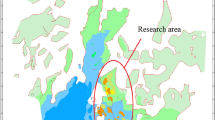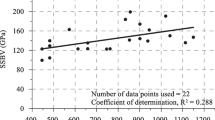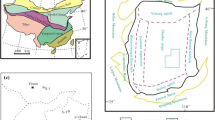Abstract
Rock brittleness directly affects reservoir fracturing and its evaluation is essential for establishing fracturing conditions prior to reservoir reforming. Dynamic and static brittleness data were collected from siltstones of the Qingshankou Formation in Songliao Basin. The brittle–plastic transition was investigated based on the stress–strain relation. The results suggest that the brittleness indices calculated by static elastic parameters are negatively correlated with the stress drop coefficient and the brittleness index B2, defined as the average of the normalized Young’s modulus and Poisson’s ratio, is strongly correlated with the stress drop. The brittleness index B2, Young’s modulus, and Poisson’s ratio correlate with the brittle minerals content; that is, quartz, carbonates, and pyrite. We also investigated the correlation between pore fluid and porosity and dynamic brittle characteristic based on index B2. Pore fluid increases the plasticity of rock and reduces brittleness; moreover, with increasing porosity, rock brittleness decreases. The gas-saturated siltstone brittleness index is higher than that in oil- or water-saturated siltstone; the difference in the brittleness indices of oil- and water-saturated siltstone is very small. By comparing the rock mechanics and ultrasonic experiments, we find that the brittleness index obtained from the rock mechanics experiments is smaller than that obtained from the ultrasonic experiments; nevertheless, both decrease with increasing porosity as well as their differences. Ultrasonic waves propagate through the rock specimens without affecting them, whereas rock mechanics experiments are destructive and induce microcracking and porosity increases; consequently, the brittleness of low-porosity rocks is affected by the formation of internal microcrack systems.
Similar content being viewed by others
References
Al-Harthi, A. A., Al-Amri, R. M., and Shehata, W. M., 1999, The porosity and engineering properties of vesicular basalt in saudi arabia: Engineering Geology, 54, 313–320.
Ai, C., Chou, D. Z., Zhang, J., and Tao, F. Y., 2017, Measurements of mechanical parameters and brittleness anisotropy of shale: Fault-block oil and gas field, 24(5), 647–651.
Brace, W. F., Paulding, B. W., and Scholz, C. H., 1966, Dilatancy in the fracture of crystalline rocks: Journal of Geophysical Research, 71(16), 3939–3953.
Bishop, A. W., 1967, Progressive failure with special reference to the mechanism causing it: In Proc. Geotech. Conf., Oslo, 2, 142–150.
Buller, D., Hughes, S. N., Market, J., Petre, J. E., Spain, D. R., and Odumosu, T., 2010, Petrophysical evaluation for enhancing hydraulic stimulation in horizontal shale gas wells: In SPE Annual Technical Conference and Exhibition Society of Petroleum Engineers.
Bian, H. Y., Wang, F., Zhang, Y. H., and Yue, C. W., 2015, Experimental study of dynamic and static elastic parameters of tight sandstones under reservoir conditions: Chinese journal of rock mechanics and engineering, 34(S1), 3045–3054.
Chen, J., Zhang, G., Chen, H., and Yin, X. Y., 2014, The construction of shale rock physics effective model and prediction of rock brittleness: 84th Annual International Meeting, SEG, Expanded Abstracts, 2861–2865.
Clark, G., 1966, Deformation moduli of rocks: ASTM STP 402, 133–174.
Davis, G. H., and Reynolds, S., 1996, Structural Geology of Rocks and Regions: 2nd edition Wiley, 19(5).
Fjaer, E., Holt, R. M., Hordrud, P., Raaen, A. M., and Risnes, R., 2008, Petroleum related rock RockMechanic: Developments in Petroleum Science Elsevier.
Goktan, R. M., and Yilmaz, N. G., 2005, A new methodology for the analysis of the relationship between rock brittleness index and drag pick cutting efficiency: Journal–South African Institute of Mining and Metallurgy, 105(10), 727–732.
Ge, X. R., 1997, Post failure behavior and a brittleplastic model of brittle rock: Computer Methods and Advances in Geomechanics, 151–160.
Guo, Z., Li, X. Y, Liu, C., Feng, X., and Shen, Y., 2013, A shale rock physics model for analysis of brittleness index, mineralogy and porosity in the Barnett shale: Journal of Geophysics and Engineering, 10(2), 25006–25015.
Guo, T., Zhang, S., Ge, H., Wang, X., Lei, X., and Xiao, B., 2015, A new method for evaluation of fracture network formation capacity of rock: Fuel, 140, 778–787.
Hucka, V., and Das, B., 1974, Brittleness determination of rocks by different methods: International Journal of Rock Mechanics and Mining Sciences and Geomechanics Abstracts, 11(10), 389–392.
Hetényi, M., 2011, Handbook of experimental stress analysis: Journal of Applied Mechanics, 45(4), 481–485.
Heidari, M., Khanlari, G. R., and Torabi, K. M., 2014, Effect of Porosity on Rock Brittleness: Rock Mechanics and Rock Engineering, 47(2), 785–790.
Jarvie, D. M., Hill, R. J., and Ruble, T. E., 2007, Unconventional shale-gas systems: The Mississippian Barnett Shale of north-central Texas as one model for thermogenic shale-gas assessment: AAPG Bulletin, 91(4), 475–499.
Li, Q. H., Chen, M., Jin, Y., Wang, F. P., Hou, B., and Zhang, B. W., 2012, Indoor evaluation method for shale brittleness and improvement: Chinese Journal of Rock Mechanics and Engineering, 31(8), 1680–1685.
Li, J., 2013, Analysis on Mineral Components and Frangibility of Shales in Dongying Depression: Acta Sedimentologica Sinica, 31(4), 616–620.
Lai, J., Wang, G., Huang, L., Li, W., Ran, Y., and Wang, D., 2015, Brittleness index estimation in a tight shaly sandstone reservoir using well logs: Journal of Natural Gas Science & Engineering, 27, 1536–1545.
Lou, N., Zhao, T. Q., and Zhang, Y., 2016, Study on calculation method about brittleness index of tight sandstone reservoirs in Qijia Oil Field: Zhongzhou Coal, (6), 140–144.
Morley, A., 1948, Strength of materials: Journal of the American Society for Naval Engineers, 71(96), 393–398.
Martin, C. D., and Chandler, N. A., 1994, The progressive fracture of Lac du Bonnet granite: In International Journal of Rock Mechanics and Mining Sciences & Geomechanics Abstracts, 31(6), 643–659.
Martin, J., 2017, A geomechanical approach to evaluate brittleness using well logs: mississippian limestone, northern Oklahoma: Msc, Thesis, The University of Texas Arlington.
Niu, G. F., 2017, Simulation-based research on prediction for tight sandstone reservoir’s mechanical parameters: Msc, Thesis, Dalian University of Technology.
Perez, A. R., 2013, Brittleness estimation from seismic measurements in unconventional reservoirs: Application to the Barnett shale: SEG Technical Program Expanded, 2258–2263.
Paul, S., and Sun, C. C., 2017, Lubrication with magnesium stearate increases tablet brittleness: Powder Technology, 309, 126–132.
Rickman, R., Mullen, M. J., Petre, J. E., et al., 2008, A practical use of shale petrophysics for stimulation design optimization: All shale plays are not clones of the Barnett Shale: Annual Technical Conference and Exhibition. Society of Petroleum Engineers, SPE 115258.
Rajabzadeh, M. A., Moosavinasab, Z., and Rakhshandehroo, G., 2012, Effects of rock classes and porosity on the relation between uniaxial compressive strength and some rock properties for carbonate rocks: Rock Mechanics and Rock Engineering, 45(1), 113–122.
Shi, G. C., Ge, X. R., and Lu, Y. D., 2006, Experimental study on coefficients of brittle stress drop of marble: Chinese Journal of Rock Mechanics and Engineering, 25(8), 1625–1631.
Sone, H., and Zoback, M. D., 2013, Mechanical properties of shale-gas reservoir rock–part 2: Ductile creep, brittle strength, and their relation to the elastic modulus: Geophysics, 78, 5–10.
Smart, K. J., Ofoegbu, G. I., Morris, A. P., Mcginnis, R. N., and Ferrill, D. A., 2014, Geomechanical modeling of hydraulic fracturing: why mechanical stratigraphy, stress state, and pre-existing structure matter: AAPG Bulletin, 98(11), 2237–2261.
Tarasov, B., and Potvin, Y., 2013, Universal criteria for rock brittleness estimation under triaxial compression: International Journal of Rock Mechanics and Mining Sciences, 59(4), 57–69.
Wang, D., Ge, H., Wang, J., Meng, F., Suo, Y., and Han, P., 2015, A novel experimental approach for fracability evaluation in tight–gas reservoirs: Journal of Natural Gas Science and Engineering, 23, 239–249.
Xu, G. C., Zhong, G. H., Xie, B., and Huang, T. J., 2014, Petrophysical experiment–based logging evaluation method of shale brittleness: Natural Gas Industry, 34(12), 38–45.
Yagiz, S., 2009, Assessment of brittleness using rock strength and density with punch penetration test: Tunnelling& Underground Space Technology, 24(1), 66–74.
Yang, L., Ge, H., Shen, Y., Zhang, J., Yan, W., Wu, S., and Tang, X., 2015, Imbibition inducing tensile fractures and its influence on in-situ stress analyses: a case study of shale gas drilling: Journal of Natural Gas Science and Engineering, 26, 927–939.
Zhang, L. M., Wang, Z. Q., Li, H. F., and Sun, H., 2008, Theoretical and Experimental Study on Siltstone Brittle Stress Drop in Post-Failure Region: Journal of Experimental Mechanics, 23(3), 234–240.
Zhao, Y., and Mao, N. B., 2015, Elastic parameter calculation and analysis of a shale-gas Well in Sorthern China: Journal of Yangtze University, 12(8), 37–41.
Zhang, Z. Z., Gao, F., Gao, Y. N., and Xu, X. L., 2010, Experimental Study of Brittle Stress Drop Coefficient of Granite Endured High Temperature: Journal of Experimental Mechanics, 25(5), 589–597.
Author information
Authors and Affiliations
Corresponding author
Additional information
This study is financially supported by Jiangsu Specially-Appointed Professors Program, and The Fundamental Research Funds for the Central Universities (No. 2016B13114).
Tan Wen-Hui received her B.S. from Suzhou University of School of Earth Sciences and Engineering in 2014. In 2016, she received her M.S. from the School of Earth Sciences and Engineering at Hohai University. Presently, she is a Ph.D. candidate in the School of Earth Sciences and Engineering at Hohai University Her research interests are rock physics and brittleness.
Rights and permissions
About this article
Cite this article
Tan, WH., Ba, J., Guo, MQ. et al. Brittleness characteristics of tight oil siltstones. Appl. Geophys. 15, 175–187 (2018). https://doi.org/10.1007/s11770-018-0680-y
Received:
Revised:
Published:
Issue Date:
DOI: https://doi.org/10.1007/s11770-018-0680-y




